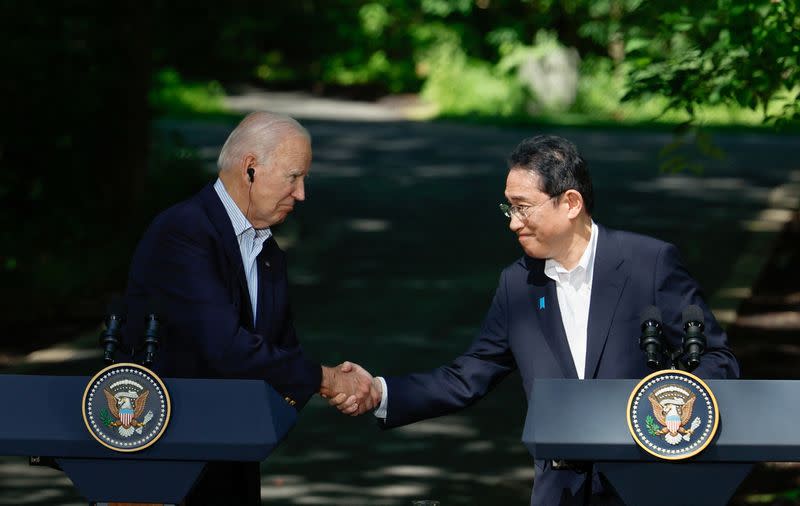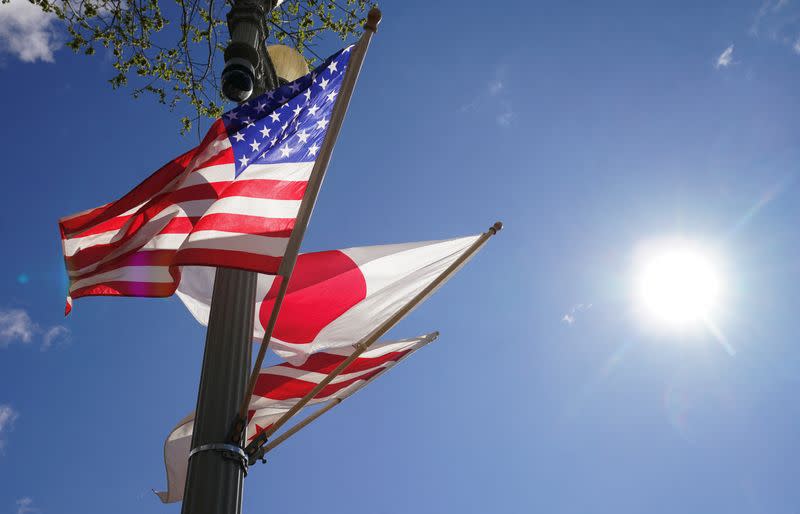Explainer-What US-Japan defense shakeup involves and why
- Oops!Something went wrong.Please try again later.
- Oops!Something went wrong.Please try again later.
By David Brunnstrom
WASHINGTON (Reuters) - U.S. President Joe Biden and Japanese Prime Minister Fumio Kishida vowed a "new era" of U.S.-Japan strategic cooperation on Wednesday, laying out a series of projects from co-development of missiles to manned moon landings with an eye on aggressive actions by China and Russia.
In a joint statement from a Washington summit, they said their aim was to build a global security partnership "fit for purpose" for complex, interconnected challenges. Biden called it the most significant upgrade since the U.S.-Japan alliance, which was first signed in 1951, began.
WHY DO THE COUNTRIES WANT TO IMPROVE MILITARY COORDINATION?
Japan and the U.S. confront a range of threats that call for closer coordination.
Topping the list is China's growing military and the threat it poses to Taiwan, just over 100 km (62 miles) from Japanese territory. Another is North Korea's nuclear and missile arsenal, and Russia's invasion of Ukraine and the fallout from Israel's war in Gaza are also shared concerns.
Japan plans to bring its military under a new joint command structure by March 2025 and says it is in discussions about ways to strengthen cooperation with the U.S. and South Korea.
WHAT IS THE MILITARY UPGRADE?
Unlike in Japan's neighbor South Korea, where U.S. and South Korean troops can operate under a unified command of a four-star general, U.S. air, land and sea forces in Japan are currently under a three-star commander subordinate to the U.S. Indo-Pacific Command (Indo-PACOM.)
The arrangement dates to a time when Japanese forces were concerned only with self-defense and the U.S. military considered Japan little more than a rest and resupply platform for operations elsewhere. It means U.S. commanders in Japan have no strategic decision-making powers and authority largely limited to managing bases and personnel, rather than working with Japanese counterparts.
Sources with knowledge of the planning have told Reuters Washington will consider appointing a four-star commander to match the rank of the head of the new Japanese headquarters that will oversee all of Japan's military operations. Experts say a U.S. officer of that rank could lay the groundwork for a future unified Japanese-U.S. command.
The leaders said details would be worked out by their foreign and defense ministers, who meet later this year, but U.S. national security adviser Jake Sullivan said this week Biden would give Kishida a "complete commitment ... to match Japan's upgrade of its own operational command, with an upgrade of our operational command."
HOW IMPORTANT IS JAPAN TO THE UNITED STATES?
Washington calls Japan its "cornerstone" ally in the Indo-Pacific and says it is a global partner too after security law changes over the past decade that have moved it away from a U.S.-authored pacifist constitution that shaped its defense planning after defeat in World War Two.
The country hosts 54,000 American troops, hundreds of U.S. aircraft and Washington's only forward-deployed aircraft carrier strike group. Bases in Japan allow the United States to project military power across the region and hem in Chinese influence.
They would be vital should China move against Taiwan, a major worry for Japan given Taiwan's position in key trade routes and production of cutting-edge semiconductors needed for the high-tech products Japan relies on to generate its wealth.
Japan has pledged to double defense spending to 2% of gross domestic product, which could make it the world's third-biggest military spender. Its plans include procuring hundreds of cruise missiles that can strike targets 1,000 km (620 miles) away.
Japan has also become important to the U.S. as a potential production base for munitions, including Patriot PAC3 anti-missile systems that will be re-exported to Ukraine, and for its shipyards, which are becoming key repair and refit yards for U.S. warships.
WHAT OTHER STEPS ARE PLANNED?
Biden and Kishida announced plans to upgrade defense communications networks and to network U.S., Australian and Japanese capabilities to counter air and missile threats.
Additionally, they will establish a forum on defense industrial cooperation to identify areas for co-development and co-production of missiles and maintenance of U.S. warships and aircraft.
Another step will be the establishment of a working group for fighter pilot training, including AI and advanced simulators, and co-development and co-production of jet trainers.
The two leaders also announced that Japanese astronauts will participate in NASA moon-landing missions.
WHAT OBSTACLES ARE THERE TO CLOSER COOPERATION?
The joint statement also said the existing three partners in the AUKUS defense project are considering cooperation with Japan on advanced capabilities and technologies across a range of areas including quantum computing, undersea, hypersonic, artificial intelligence and cyber technology.
However, officials and experts have stressed the need for Japan to take the steps to improve its intelligence apparatus, cyber defenses and rules for guarding secrets, which remain weak links.
In February, Japan said it would introduce economic security legislation to allow it to classify more information as confidential and ask employees at companies with access to it to undergo security clearance checks. It has also said it will bolster cybersecurity.
(Reporting by David Brunnstrom in Washington; Additional reporting by Tim Kelly in Tokyo and Idrees Ali and Trevor Hunnicutt in Washington; Editing by Don Durfee and Matthew Lewis)


